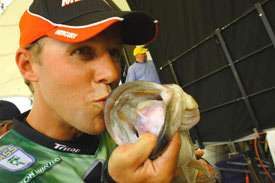
"I started rollin' down that lost highway."
— Hank Williams
Not a bad strategy when it comes to looking for a nearly year-round bass habitat. But unlike the sorrowful tune that ol' Hank moaned in 1949, roadbeds are a sort of lost highway that are often a magnet for largemouth in reservoirs throughout the country.
Trap the rushing waters of a major river — along with a few of its tributaries — and roadways old and new, large and small, straight and serpentine, surrender their purpose. They may have relinquished that purpose to humans, but these forgotten by-ways become underwater highways that bass follow to migrate through seasonal changes, adjust to fluctuating weather conditions and congregate in sizable schools.
Roadbeds are generally neither difficult to locate nor hard to fish. In some reservoirs, they can be widely known community holes; yet on others they can harbor some of the least pressured bass populations in an entire river/reservoir system.
Either way, these abandoned roads still produce good fishing. It just takes two different approaches.
"Roadbeds are always good," says former Bassmaster Angler of the Year Aaron Martens, who has fished the structures from California to Alabama. "A lot of times they are community holes, so they get a lot of pressure. Like on Guntersville, roadbeds are kind of worn out. There are a bunch of them here, but there is always a boat on them because they're kind of obvious on a map. Everybody can find them.
"But some lakes we go to have a whole bunch of roadbeds and they are a factor. There are so many that a lot of them don't get pressured. And you find a sleeper."
Bassmaster Elite Series competitor Mike Wurm is another fan of roadbeds.
"As far as roadbeds are concerned, they are easy to fish," the Arkansas pro notes. "There is nothing hard about fishing a roadbed because it usually has very little cover associated with it.
"You have to have patience and be able to decipher where the fish are going to be and how they are going to relate to the roadbed. You have to consider the time of year, the water color, the water clarity, the wind direction and whether it is sunny or overcast. But patterning bass on a roadbed is far easier than it can be with other types of structure."
General Roadbed Rules
Former three-time Bassmaster Angler of the Year Bill Dance emphasizes that not all roadbeds are equal.
"The key is targeting the old roads that are different and have some type of irregularity on them," the long-time television host advises. "Some roadbeds simply aren't well-defined. But if it has good definition with ditches on both sides, culverts, crosses creeks, or is raised and stands a couple of feet higher than the surrounding terrain, it can be a super spot.
"Once I locate a roadbed, I spend several minutes closely examining it with my depthfinder, looking for an unusual feature on it. If it is at the right depth, the best place on it often is where it crosses a creek, drain or small river channel. On an improved road, you will usually find at least a culvert or two, and possibly a bridge. Most culverts and bridges are reinforced with concrete or steel, so when you pass over them, you will see a very definite echo on your depthfinder.
"If the road is straight — and most roadbeds are fairly straight — I'll put out a couple of markers and troll along it with my trolling motor. This is the easiest way to fish it. One of the most productive tactics for fishing a quarter- or half-mile stretch of a roadbed is to stay on the edge of this underwater road on the side that has the deeper ditch."
Prime real estate on roadbeds, what Martens calls "sweet spots," can include bridges, intersections, ditches, culverts, potholes, fencerows, bends and curves.
Intersections are among the most common — and productive — areas of these lost highways. These junctions usually involve a creek or river channel where a bridge was built to cross it. But an intersection can be where a roadbed intercepts with another road, treeline or section of low-lying land that was once dry. The juncture of a roadway with a creek channel, though, can be a bass mine because it provides such attractive ingredients as a variety in depth, plenty of objects (cover) and current that still funnels baitfish through a relatively confined area.
"This is a bonanza situation," Wurm states. "With an intersection, you've got four points to fish, four areas where a school of bass could be attracted."
Martens is particularly fond of fishing guardrails along the sides of a roadbed (which usually indicates a sizeable depth change off of the road). He believes bass will hold on the outside of these metal or concrete rails and ambush baitfish that are blown or drift across the flat surface of the thoroughfare.
"Nowadays, our electronics are really good, so a lot of times you can find these places by just idling over them," Martens says. "You can see where the rocks are located. Metal guardrails are easy to see. Concrete looks more square on your graph."
When it comes to locating bass on roadbeds, Martens' primary tools are a spinnerbait and both lipped and lipless crankbaits: a Norman DD22 (for probing the deepest spots) and Rat-L-Trap for covering shallower stretches.
"A roadbed might be 2 miles long and it all may look the same, but those fish will school on anything," he adds. "So I throw a DD22 or slow roll a spinnerbait until I find one. Usually if you find one fish, you'll find more on a roadbed. Usually if you catch one fish, you know there's five or 10 there. Or 20 or 30."




